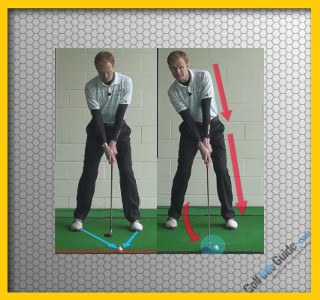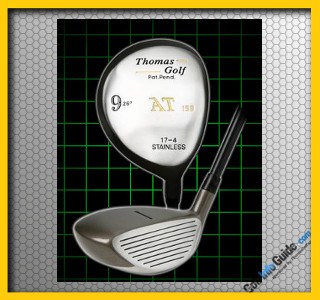- Shallow angle of attack. Unlike when you are hitting an iron shot, you want your fairway woods to be coming into the ball from a shallow angle. Hitting down steeply on the ball is going to create more backspin than you want in order to achieve optimal flight. By coming in to the ball while the club is moving mostly flat along the top of the turf, you will be able to use the true loft of the club to launch the ball into the air with a relatively low spin rate. In this way, a fairway wood swing is very similar to a driver swing, as you also want to use a shallow angle when hitting your driver. Of course, the ball won't be teed up as high (or at all) when hitting a fairway wood, so be sure to stay down through the shot until impact has been made.
- Avoid an inside path. If you are swinging down too far from the inside, you will run the risk of hitting the shot fat and coming up well short of your target. This happens when you combine the shallow angle of attack from the point above with a swing path that is coming from too close in to your body. When those two elements combine in your swing, there simply won't be enough room to get to the ball without hitting the ground first. When playing a fairway wood shot, be sure to get great extension on the backswing so you will have plenty of space to make your downswing properly.
- Eyes on the ball. This is a point that applies to the impact position of every club in your bag, but it is important to emphasize it here while talking about fairway woods. If you allow your eyes to move up and away from the ball prior to impact – likely to look for the flight of the ball before it has ever left – you will risk making poor contact with the shot. Solid contact is crucial if you are going to get the maximum distance from your swing, so watch the ball carefully and don't allow your eyes to move up until you have sent the ball on its way.

2. The Perfect Fairway Wood: #7
The club-length of a #7 wood is about 1 inch shorter than a 5 wood wood, making it much easier to consistently hit the sweet spot.
The #7 wood will have about 10 more grams of sole head-weight compared to a 5 wood wood. This additional sole weight will help you in two ways; getting the ball up quicker off the fairway or out of a fairway bunker.
The #7 wood gives you added flexibility to hit the ball high over obstacles and carry over long drops. The 7 wood is a great go to club and for some golfers, it has become their favorite club. The golfer get”s the feeling they can depend on their 7 fairway wood even under pressure during a round.

3. How To Hit A 3-Wood From the Fairway
For the most part, hitting a fairway wood is not significantly different from hitting a driver. Fairway woods are designed similarly to drivers, only with smaller club heads. Therefore the flatter swing that you use with your driver as compared to your irons will apply nicely to your fairway woods as well. However, despite these similarities, there are a couple of changes to your technique that you will want to be aware of.
To start, your ball positionneeds to be adjusted back in your stance by a couple of inches. The distance that you move the ball back in your stance depends on the specific fairway wood that you are hitting. For example, you would only need to move the ball back an inch or two when hitting a golf 3 wood, but the proper ball position for a golf 11 wood should be close to the middle of your stance. For any club between a 3 wood and a golf 11 wood, you will want to find the right position that allows you to stay balanced and make solid contact at impact. Locating a comfortable ball position for you with all of your fairway woods is a job that will take a little time, but it is certainly worth the effort to get it right.

4. Thomas Golf Fairway Woods Loft Chart
Club Equivalent to our Loft Lie Head Material Length (inches) Size (cc) 
Picking targets with your fairway woods is pretty similar to picking a target with any of your other clubs. The key is understanding the trajectory that you are going to hit with a given fairway wood, and then choosing your target to allow for that ball flight. For example, your golf 3 wood is going to come into the green on a flatter trajectory than your golf 7 wood, so the target you select will be based on how much bounce and roll you are planning on after the shot lands. What might be a safe target line for your 7 wood could be too dangerous to try with your 3 wood. It isn’t as easy to get the ball to stop quickly with a fairway wood as it is with a short iron, so the roll out always needs to be accounted for.
When using your fairway woods off the tee, you want to focus your target picking efforts on taking as much trouble out of play as possible. The point of using your fairway wood off the tee in the first place is to get the ball in the fairway, so pick out the safest line that you can find and hit your shot in that direction. That means keeping the ball away from bunkers, water hazards, trees, etc. While this strategy might leave you with slightly longer approach shots than if you took a more aggressive line, you will come to appreciate how many shots you get to hit into the green from the short grass. Golf is hard enough as it is, you don’t want to make the game any harder by playing from the rough.

6. Ball Position Key to Hitting High-Lofted Fairway Woods
The list below highlights some of the biggest advantages to this class of golf clubs.
- Get the ball off the ground with ease. The biggest complaint from the average golfer regarding long irons is the fact that they are difficult to get off the ground. If you have average swing speed in your game, you might find that it is hard to get the ball up in the air sufficiently when hitting a long iron. Specifically, you will notice that you have to catch the ball just perfectly in order to achieve height on the shot. Any degree of miss-hit will cause the ball to fly low and land short of the target. While professional golfers are able to launch their long irons with relative ease, that is not a skill that is within the realm of the typical amateur. So, to make your life on the course easier, consider using lofted fairway woods, which are far more forgiving and will make it dramatically easier for you to get the ball airborne time after time.
- Bring the ball in soft. Another challenge that is faced by the average amateur when it comes to long irons is the way the ball typically comes into the green. Even if you do manage to hit the green on the fly with your long or mid-iron shot, you may find that the ball lands hard and bounces over the back. Obviously, this is not a good outcome, as hitting your ball over the back of the green usually leads to big trouble. To bring the ball in higher, and softer, you may wish to try a lofted fairway wood. These clubs, as mentioned above, make it easy to hit the ball high in the sky. With a higher trajectory, the ball will land softer and will be less likely to bounce or roll over the back. It is a great feeling to stand in the fairway knowing that you can bring the ball in softly to the target, and that is not a feeling that you are likely to experience when holding a long iron.
- Deal with the rough. Yet again, we find a point where the lofted fairway wood will usually outperform a long iron. If you have ever tried to hit a long iron from the rough – even the light rough – you know what a challenge it can be. The hosel of your iron is likely to become twisted up in the grass, and you may not be able to hit the ball cleanly at all. Even if you do make decent contact, the ball is going to come out low and with nearly no backspin. In the end, you will be left with a shot that is hard to control and is only useful in a very limited number of circumstances. On the other hand, playing a lofted fairway wood from this kind of lie can be far more effective. The design of the club will help it to cut through the grass, and the ball should jump up into the air on most occasions. You would you always prefer to play from the fairway, of course, but hitting in from the rough with a lofted fairway metal is a challenge that you should be able to handle.
- Off the tee
- From a clean fairway lie
- From the light rough
- Out of a fairway bunker (as long as the sand is firm and the lip is low)
- From around the edge of the green as a chipping option
- Stand a few feet behind the ball, with the ball directly between you and the line you want it to fly on.
- Find a mark within a few feet of the ball, and directly between ball and target. This may be a divot, a leaf or discolored patch of grass, for example.
- When setting up to the ball, aim the clubface at the mark.
- Align the feet, shoulders and hips with the clubface.
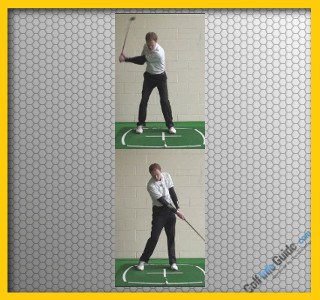
1. Hit Fairway Woods Correctly, 3 and 5 Wood
The following three points should all be present when you slam your three or five wood into the back of the golf ball.

Fortunately, there are plenty of lies and situations that you will encounter on the course that are perfect for the use of a lofted fairway wood. A partial list of the situations that should be considered a 'green-light' for a lofted fairway wood includes the following –
As you can see, you shouldn't be hurting for opportunities to deploy your lofted fairway woods. The list above contains lies that you are going to see frequently on the course, so you are almost certain to use your fairway woods at least a few times per round – if not more.
There are a few things to keep in mind, however, even when playing from these ideal types of lies. For one thing, you need to tee the ball low when playing a lofted fairway wood off of the tee. The sweet spot on a fairway wood is going to be much lower to the ground than it is on your driver, so teeing the ball up high would be a big mistake. There is plenty of loft on the club to get the ball nicely up into the air, so you shouldn't need to worry about teeing the ball high to help you get elevation on the shot. Tee the ball up with just a little bit of air between the bottom of the ball and the top of the grass and you will be good to go.
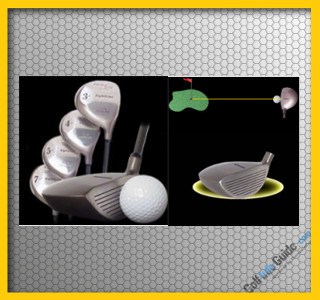
8. Best Choices and Opportunities with Fairway Woods
The technical and material's advances include:
Lighter, Stronger Metals
New-age steels and titanium has been used to provide new advantages in recent years. Because they are lighter and stronger, these materials allow the club designer to maintain the strength of the club head and place more weight on the sole, the toe, the heel and the back, for greater stability upon impact.
Lighter Stronger Lofts
The ‘new’ fairway woods provide added distance through a stronger loft made possible by a lower center of gravity.
Low Center of Gravity
An increased sweet spot is the result of being able to concentrate the weight in the sole and the outside of the club head.
Trouble Clubs
You might want to consider making one of your fairway ‘woods’ a ‘trouble/hybrid’ club. These usually have a rounded sole to help ensure solid contact from a less than perfect lie.
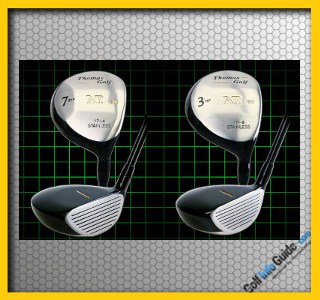
9. Thomas Golf AT190 (Black) Fairway Woods
Professional instructors around the world emphasize these factors as the essential elements to achieving a successful swing and ball flight.
– Aim and Alignment –
The level top-plane makes the Thomas Golf technology possible. The indicator bar is now parallel with the target line and level to the ground. This gives the golfer the advantage of tri-axial alignment, the ability to correctly adjust loft, lie, and direction.
– Greater Strength and Distance –
Clubs with traditional roll and bulge tops will flex when they make contact with the ball, and power is lost. The straight design of the Advanced TopPlane eliminates unnecessary flex and delivers more power, effortlessly sending your shot further.
– Improved Sweet-Spot Location –
The Advanced TopPlane lowers the center of gravity so that the sweet-spot of the club is automatically aligned with the sweet-spot of the ball. This was all accomplished without reducing the size of the face or sweet spot.
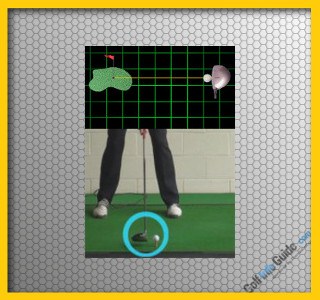
10. Fairway Woods Correct Alignment
Even with a solid method, it can be difficult to place the clubface so that it’s perfectly square to the target line. All fairway woods manufactured by Thomas Golf (www.thomasgolf.com) feature a patented aiming guide that assures pure alignment every time.


